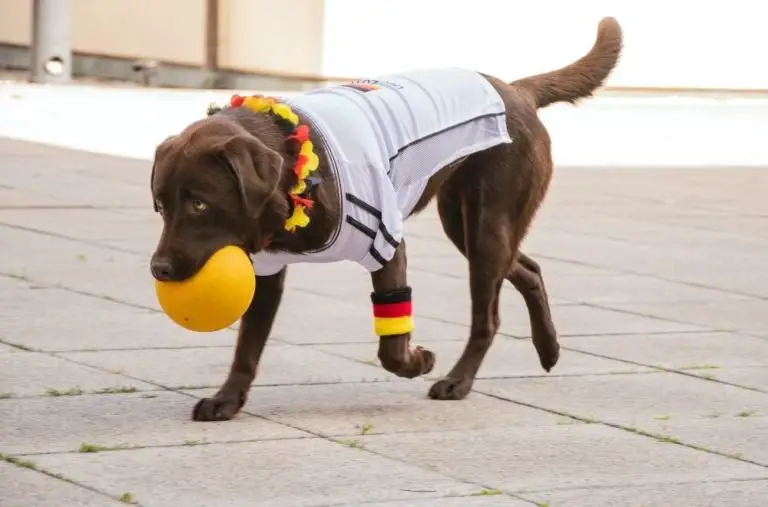Why Does My Black Lab Have A White Chest? A Guide To Unusual Labrador Markings
Are you wondering why your black Labrador has a white chest? Labradors are super cute, whether it be yellow or black. They make great companions and friends to human beings.
But, does the white marking on your black Lab disturbs you? Do you think white markings occur only on black Labradors?
Both Black and Yellow Labradors can have a white chest. The white chests of Labradors don’t essentially mean that they are not purebred. Labrador’s coat color is the result of interaction between certain alleles. Therefore, the purebred Labradors also can have a white chest or any unusual markings.
Even the purebred Labradors can have several unusual markings, including a white chest. You would find several unusual markings on your Labradors. But that would necessarily not mean that they are not purebred ones.
So, here is our article with more details about unusual Labrador markings. We hope the information provided will help you clear all your queries about the topic.
Is Black Labrador With A White Chest Purebred?
A white unusual or white chest of your Labrador, doesn’t mean that they are not purebred. The unusual markings or color changes in the coat of your Labradors may not necessarily imply that they are not a purebred one.
The fur coat of Labradors is control by certain alleles. It is the difference in the distribution of alleles that brings white chests and unusual markings in Labradors. And mostly, it has nothing to do with the breed purity of your Labrador.
The unusual markings and white chests are not just common among black Labradors. Even the yellow Labradors are found to have a white chest, but it is just not noticeable as in black Labradors.
The Cause Of Unusual Labrador Markings
The three colors of Labradors recognized and accepted by the American Kennel Club are yellow, black, and brown.
But, you can see a lot of color variations in dogs with these three colors.
Although black is the original color of Labradors, you will literally find Labradors from pale yellow to silver colors.
Do you really know what brings color variations among Labradors?
Let us look at what really has a role in determining the coat color of Labradors.
The two sets of genes ‘Bb’ and ‘Ee’ or the two alleles ‘B’ and ‘E’ control the coat colors of Labradors.
When the gene ‘B’ is dominant in an individual, it turns to be a Black, and when the dominant gene is b, the Labrador turns to be Brown. That is how it usually works.
The ‘Bb’ genes are nullified, and the individual turns to be a yellow one if it possesses recessive ‘e’ genes.
So, the difference in gene distribution of Labradors is the cause for white markings in Labradors.
What Are The Common Mismarks Seen On The Coats Of Labradors?
The unusual markings most commonly seen among Labradors are listed out here.
Tan Points or Black Markings

The tan points or black marking commonly appear on the paws, chest, muzzle, or above the eyes of Labradors.
Most people once misunderstood tan points on Labradors to be a result of their interbreeding with Gorden Setters. But later, it was proven to be the result of the appearance of recessive genes in the Labradors.
Brindling Effects
Brindling is the appearance of black and red colors in the coat of Labradors. You will find multi-color patches or streaks on the coat of Labradors with Brindling effects.
The America Kennel Club doesn’t usually approve Labradors with Brindling effects as show dogs.
The Brindling effects can occur over the entire body of your Labrador or only in certain places such as muzzle, legs, chest, and paws.
Mosaic
Mosaic is the appearance of yellow and black patches that are one of the most unusual markings seen on the coats of Labradors.
The Mosaic condition can actually occur in the Labradors due to two reasons, either by Chromosome nondisjunction or by a Chromosome loss.
Graying
Graying in Labradors actually occurs once they start aging. The signs of graying firstly occur in the muzzle region and paws of the Labradors.
The graying actually occurs due to a reduction in the number of melanocytes due to aging.
The graying may also occur due to tissue injuries that would result in the reduction of melanocyte production.
White Ring Around The Tail
Some Labradors may have white rings around their tail. However, in some individuals, these white spots get covered with fur as they grow.
Labradors with a white ring around their tail might also have a red undertone on their coat, giving them a two-toned appearance.
Bolo Mark
Bolo mark is the appearance of white spots around the paws of Labradors.
However, puppies born with Bolo marks usually get these white spots around their paws get faded or covered as their fur grows further.
The Bolo marks are interestingly believed to be a mark usually seen among the descendants of Banchory Bolo, the first dual champion dog.
Do Unusual Markings On Labradors Implies That They Are Not Purebred?
As said with the white chest of Labradors, their unusual markings also don’t imply that they are not purebred.
The unusual markings on the coat of Labradors are a result of the appearance of recessive genes or a decrease in melanocyte production, or even due to accidental cell division that occurs.
However, if you still do not have clarity on the pure line of your Labrador, the next section of the article will give you some tips.
How To Tell Whether Your Labrador Is Purebred?
First of all, you should understand that the temperament or other features of your dog will not get affected by unusual markings formed due to gene distribution or melanocyte production.
That means, your dog would have the temperament and other features as per the official purebred standards described by the American Kennel Club.
So, the best thing to do is to evaluate your Labrador’s temperament, size, food habits, and other physical features on the basis of standards established by the American Kennel Club.
You can go for a DNA test if you are still not satisfied with the results of your evaluations.
Many kinds of DNA test kits for dogs are available online. These kits would cost anywhere between $50 to $190.
The DNA kits for dogs would contain a cheek swab, which you should have to send to a genetics laboratory. And you would get the results by a couple of weeks.
Conclusion
An unusual marking or white chest of your Labrador doesn’t mean that they are not purebred.
The unusual markings on the coat of Labradors are mostly due to differences in allele or gene distribution or appearance. It hardly says anything about the pure line of your dog.
Several kinds of DNA kits are available online, you can make use of it to know whether your dog is purebred. Or you can seek the help of a veterinarian to know the real cause for the unusual marking on your dog’s coat.







